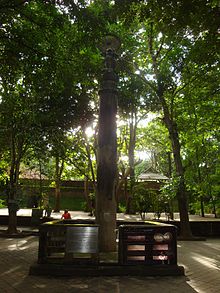
The Emerald Buddha is an image of the meditating Gautama Buddha seated in a meditative posture, made of a semi-precious green stone, clothed in gold. and about 66 centimetres (26 in) tall. The image is considered the sacred palladium of Thailand. It is housed in the Temple of the Emerald Buddha on the grounds of the Grand Palace in Bangkok.
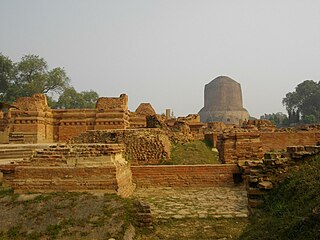
Sarnath is a place located 10 kilometres northeast of Varanasi, near the confluence of the Ganges and the Varuna rivers in Uttar Pradesh, India.

Chiang Mai is the largest city in northern Thailand, the capital of Chiang Mai province and the second largest city in Thailand. It is 700 km (435 mi) north of Bangkok in a mountainous region called the Thai highlands and has a population of 1.2 million people as of 2022, which is more than 66 percent of the total population of Chiang Mai province.
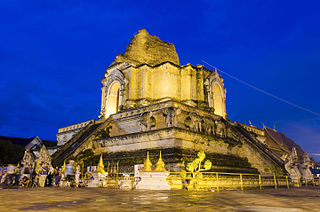
Wat Chedi Luang is a Buddhist temple in the historic centre of Chiang Mai, Thailand. The current temple grounds were originally made up of three temples — Wat Chedi Luang, Wat Ho Tham and Wat Sukmin.

The pillars of Ashoka are a series of monolithic pillars dispersed throughout the Indian subcontinent, erected—or at least inscribed with edicts—by the 3rd Mauryan Emperor Ashoka the Great, who reigned from c. 268 to 232 BC. Ashoka used the expression Dhaṃma thaṃbhā, i.e. "pillars of the Dharma" to describe his own pillars. These pillars constitute important monuments of the architecture of India, most of them exhibiting the characteristic Mauryan polish. Twenty of the pillars erected by Ashoka still survive, including those with inscriptions of his edicts. Only a few with animal capitals survive of which seven complete specimens are known. Two pillars were relocated by Firuz Shah Tughlaq to Delhi. Several pillars were relocated later by Mughal Empire rulers, the animal capitals being removed. Averaging between 12 and 15 m in height, and weighing up to 50 tons each, the pillars were dragged, sometimes hundreds of miles, to where they were erected.

Wiang Kum Kam is an historic settlement and archaeological site along the Ping River, which was built by King Mangrai the Great as his capital before he moved it to Chiang Mai. It was flooded and abandoned more than 700 years ago; that move became more understandable in 2005, when the ancient city was flooded three separate times as the river overflowed its banks in that area of Chiang Mai.

The dharmachakra or wheel of dharma is a widespread symbol used in Buddhism. The symbol also finds usage in Hinduism, particularly in places that underwent religious transformation, and in Jainism and in modern India.

Wat Phra That Doi Suthep is a Theravada Buddhist temple (wat) in Chiang Mai Province, Thailand. The temple is often referred to as "Doi Suthep" although this is actually the name of the mountain where it is located. It is a sacred site to many Thai people. The temple is 15 kilometres (9.3 mi) from the city of Chiang Mai and situated at an elevation of 1,073 meters. From the temple, impressive views of downtown Chiang Mai can be seen.

A wat is a type of Buddhist and Hindu temple in Cambodia, Laos, East Shan State, Yunnan, the Southern Province of Sri Lanka, and Thailand.

Inthakhin is the name of the Lak Mueang of Chiang Mai. It is said that the pillar was first erected by King Mangrai at the founding of the city on April 12, 1296 CE at Wat Sadue Mueang on Inthawarorot road. It was brought to its present location inside a shrine on the temple grounds of Wat Chedi Luang by the Lanna king Kawila in 1800 CE.
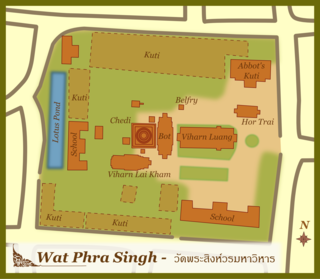
Wat Phra Singh is a Buddhist temple in Chiang Mai, northern Thailand. King Ananda Mahidol, bestowed upon it the status of Royal temple of the first grade in 1935.
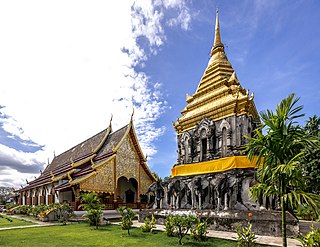
Wat Chiang Man is a Buddhist temple inside the old city of Chiang Mai, in northern Thailand.

Wat Lok Moli is a Buddhist temple in Chiang Mai, northern Thailand. The temple is situated on the north side of the north moat surrounding the old part of the city, about 400 meters west of the Chang Phuak city gate.

Bai sema are boundary stones which designate the sacred area for a phra ubosot within a Thai Buddhist temple (wat); otherwise called sema hin (เสมาหิน).
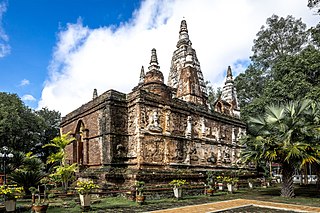
Wat Chet Yot or officially called Wat Photharam Maha Wihan is a Buddhist temple (Wat) in Chiang Mai in northern Thailand. It is a centre of pilgrimage for those born in the year of the Snake.
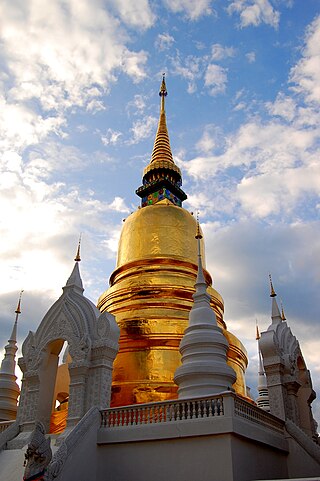
Wat Suan Dok, also known as Wat Buppharam is a Buddhist temple (Wat) in Chiang Mai, northern Thailand. It is a Royal Temple of the Third Class. The temple is on Suthep Road, approximately one kilometre west of Suan Dok gate at the west side of the moat.

Wat Pa Daeng is a Buddhist temple located in Chiang Mai, Thailand. Wat Pa Daeng historically served as the center for the Araññavasi forest-dwelling monks, who established a new sect at this monastery. The temple is near Wat Umong.

Yotchiangrai was the tenth monarch of the Mangrai Dynasty that ruled Lan Na in what is now northern Thailand. Ruling between the death of his grandfather Tilokaraj in 1487 and the crowning of his son in 1495, his reign is known as the centre of the Golden Age for the kingdom. During this period, the kingdom saw a flourishing of Buddhist art.

